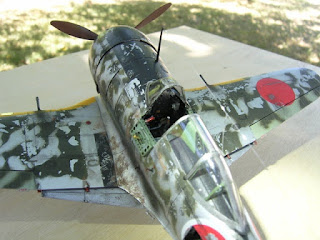Iskender Mailibayev has kindly shared these images and details of his exacting build of the venerable Hasegawa J2M3 Raiden 'Jack' in 1/72 scale, using the 2004 '302nd Flying Group' re-release.
To begin with Iskender compared the 1977 kit parts with several sets of plans and photographs of the actual aircraft, concluding that the plans in the Model Art profile most closely represented the original. He found that the kit fuselage appeared 2mm too short in the tail section so lengthened it by inserting Evergreen plastic spacers in cuts carefully aligned to preserve the tapering shape of the airframe. Iskender also re-built the under cowling oil cooler intake as the kit version was found to be undersized and incorrect in shape.
Iskender further enhanced his model by using the excellent Resin Art aftermarket set, together with Master Model Type 99 brass gun barrels, CMK landing lights and MYK Design decals. The cockpit interior was finished using AK Real Color RC306 IJN Mitsubishi Interior Green.
For finishing the model Iskender used a mixture of Tamiya and Mr Color paints - Mr Color C124 Dark Green (Mitsubishi) for the upper surfaces, Tamiya XF-76 Gray Green (IJN) for the under surfaces and the leading edge IFF strips in Mr Color 58 Orange Yellow IJN /IJA Aircraft.
Iskender found the build complex, involving a lot of aftermarket additions and scratchbuilding techniques, but ultimately satisfying. A fully detailed and step-by-step build report with many more images may be found at the Scalemodels.Ru forum here .
With very special thanks to Iskender for sharing these images and details of his excellent Raiden model built from a 43 year old kit 'still going strong'!
Image credits: All model photos © 2020 Iskender Mailibayev; Box art © 2004 Hasegawa Corporation
























































